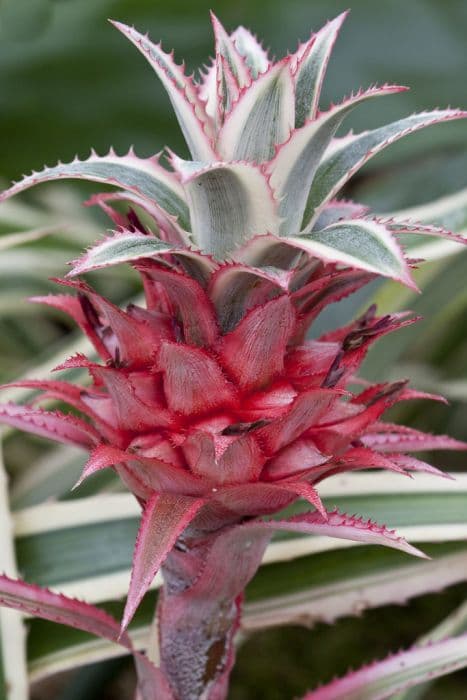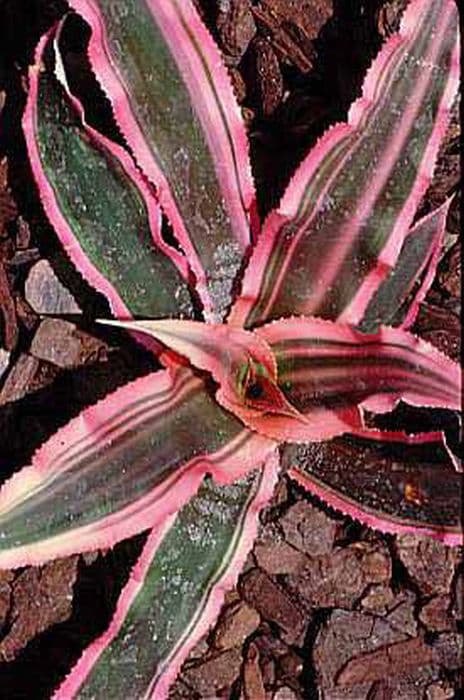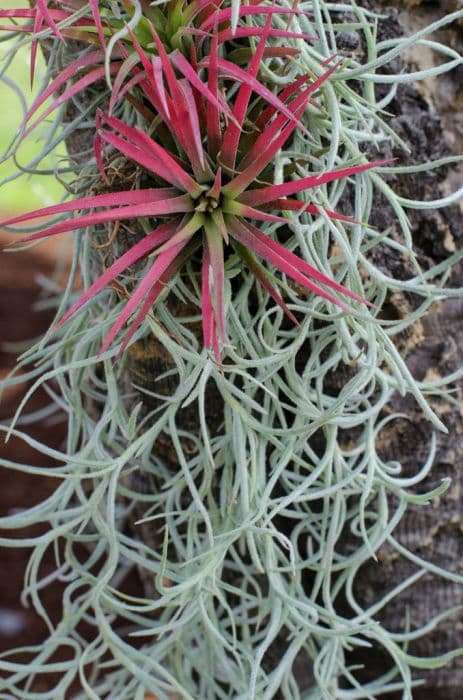West Indian Tufted Airplant Guzmania monostachya

ABOUT
Guzmania monostachya, more commonly known as the West Indian tufted airplant, is a striking tropical plant that is admired for its distinctive appearance. The plant has a rosette of thin, arching leaves that are typically bright green in color. These leaves are smooth and may have a glossy appearance, with their edges being slightly wavy or toothed, giving the plant a lush, full look. At the center of this rosette emerges a singular flower spike, which is the standout feature of the plant. The spike is surrounded by showy bracts, which are leaf-like structures that can be vibrant red, yellow, or orange, creating a bold contrast against the green foliage. These bracts, which can sometimes be mistaken for the flower itself, are designed to attract pollinators. The actual flowers are small and less conspicuous, often nestled within the bracts. The entire floral display is quite elaborate and offers an exotic and colorful focal point, making the West Indian tufted airplant a favorite among enthusiasts for adding a tropical flair to their environment. This plant's combination of striking bracts and unique foliage makes it a visually appealing specimen that draws attention wherever it is displayed.
About this plant
 Names
NamesFamily
Bromeliaceae
Synonyms
West Indian Tufted Airplant
Common names
Caraguata monostachya, Guzmania lingulata var. monostachya, Tillandsia monostachya, Vriesea monostachya.
 Toxicity
ToxicityTo humans
Guzmania monostachya, commonly known as the West Indian tufted airplant, is not known to be toxic to humans. Therefore, ingestion of this plant typically does not lead to poisoning or adverse health effects. It is always best to err on the side of caution and avoid ingesting plants not meant for consumption.
To pets
Guzmania monostachya, commonly referred to as the West Indian tufted airplant, is not recognized as being toxic to pets. Ingesting this plant should not cause poisoning or serious health issues in pets. However, non-toxic plants can sometimes cause mild digestive upset if pets are not accustomed to eating them or if they ingest large amounts.
 Characteristics
CharacteristicsLife cycle
Perennials
Foliage type
Evergreen
Color of leaves
Green
Flower color
Red
Height
1-2 feet (30-60 cm)
Spread
1-2 feet (30-60 cm)
Plant type
Bromeliad
Hardiness zones
10
Native area
Central America
Benefits
 General Benefits
General Benefits- Aesthetic Appeal: Adds a vibrant pop of color and tropical flair to indoor and outdoor settings with its bright inflorescence.
- Low Maintenance: Requires minimal care, making it suitable for those with busy lifestyles or new to plant care.
- Long Blooming: The bracts of the inflorescence can remain colorful for several months, providing long-lasting decorative value.
- Humidity Tolerance: Thrives in humid environments, which can be beneficial in bathrooms or kitchens where other plants might struggle.
- Adaptability: Can grow in various light conditions, from low to bright indirect light, offering flexibility in placement.
 Medical Properties
Medical PropertiesThis plant is not used for medical purposes.
 Air-purifying Qualities
Air-purifying QualitiesThis plant is not specifically known for air purifying qualities.
 Other Uses
Other Uses- Guzmania monostachya can be used as a natural container or vase for holding small items, as the rosette of leaves creates a natural cup-like structure.
- The plant’s durable leaves can be artistically crafted into unique natural jewelry pieces like earrings or pendants.
- Its bright colors and intriguing shape allow it to be integrated into unconventional living art installations and vertical gardens.
- The plant can serve as a living gift or decoration, symbolizing warmth and hospitality in many cultures.
- Guzmania monostachya can be used in educational settings as a model to teach botany and horticulture, specifically bromeliad care and reproduction.
- The plant can be used as a natural indicator for humidity levels, as its leaves tend to curl in drier conditions.
- As a non-toxic plant, it can be safely grown in classrooms or pet-friendly homes without concern for poisoning.
- In symbolic landscape design, Guzmania monostachya can represent tropical beauty or exotic allure in thematic gardens.
- The plant can act as a companion plant in the greenhouse, providing shade or humidity for other humidity-loving tropical plants.
- It can be utilized in crafting, for example, by incorporating its bright bracts into homemade paper or natural potpourri.
Interesting Facts
 Feng Shui
Feng ShuiThe plant_name is not used in Feng Shui practice.
 Zodiac Sign Compitability
Zodiac Sign CompitabilityThe plant_name is not used in astrology practice.
 Plant Symbolism
Plant Symbolism- Exotic Beauty: Guzmania monostachya, commonly known as the Guzmania, is often associated with exotic beauty due to its vibrant and unique floral bracts that catch the eye.
- Uniqueness: The distinct appearance of the Guzmania's inflorescence symbolizes standing out and celebrating individuality in a world full of diversity.
- Hospitality: Like many bromeliads, the Guzmania can symbolize hospitality, perhaps because of its welcoming, bright colors and resemblance to the pineapple, which is another recognized symbol of hospitality.
- Warmth: Coming from tropical environments, the Guzmania represents warmth and comfort, something that can reflect the warmth of a person's personality or a cozy, inviting home environment.
- Vitality: The plant's ability to thrive in various conditions without soil is often seen as a symbol of vitality and resourcefulness.
 Water
WaterGuzmania, commonly known as the West Indian Tufted Airplant, should be watered by filling its central cup with water, while sparingly watering the soil. The central cup should be flushed with fresh water every few weeks to prevent stagnation and bacterial growth. This species prefers to be kept consistently moist but not waterlogged, requiring roughly 4 to 6 ounces of water per week depending on the humidity and temperature of the environment. It's important to water in the morning to allow any excess water on the foliage to dry throughout the day. Over-watering can lead to root rot, so it's crucial to ensure the plant has adequate drainage.
 Light
LightThe West Indian Tufted Airplant thrives in bright, indirect light. Direct sunlight should be avoided as it can scorch the leaves. A spot near an east-facing or north-facing window would provide ideal light conditions or in a shaded area of a south or west-facing window. This plant can also adapt to fluorescent lighting, making it suitable for office environments.
 Temperature
TemperatureFor the West Indian Tufted Airplant, the ideal temperature range is between 60 to 80 degrees Fahrenheit. They can survive minimum temperatures down to around 40 degrees Fahrenheit but will suffer if exposed to temperatures below freezing. To encourage flowering and maintain plant health, keep them in warmer conditions within the ideal range.
 Pruning
PruningPruning the West Indian Tufted Airplant is mainly focused on removing dead or dying leaves to maintain its appearance and prevent rot. Trimming should be done using sterilized scissors or shears, cutting back any dead foliage at its base. This species doesn't require frequent pruning; you can do it as needed, particularly after blooming, to tidy up the plant. The post-flowering period is also a good time to prune since it can stimulate the growth of pups, or offsets.
 Cleaning
CleaningAs needed
 Soil
SoilThe Vase Plant prefers a well-draining soil mix like orchid bark mixed with peat and perlite, in a ratio of 2:1:1. The ideal soil pH for the Vase Plant is slightly acidic to neutral, around pH 5.5 to 7.
 Repotting
RepottingVase Plants should be repotted every two to three years or when the potting mix breaks down. They are often repotted after they finish blooming.
 Humidity & Misting
Humidity & MistingThe Vase Plant thrives in high humidity conditions, ideally between 60% to 80%. Maintaining high humidity is essential for its growth.
 Suitable locations
Suitable locationsIndoor
Use bright, indirect light and high humidity for Vase Plant indoors.
Outdoor
Place Vase Plant in shade and protect from cold; mist regularly.
Hardiness zone
10-12 USDA
 Life cycle
Life cycleGuzmania monostachya, commonly known as West Indian tufted airplant, begins its life cycle as a seed that germinates in the canopy of trees in its native tropical forest habitat, using the crevices in bark as an anchor. The seedling develops into a rosette of strap-like leaves, relying on rainwater and airborne or canopy debris for nutrients. The plant goes through a vegetative growth phase where it enlarges and matures, capable of photosynthesis to sustain itself. Once mature, the plant produces a colorful inflorescence which is a signal that it has entered the reproductive stage, attracting pollinators such as birds or insects. After pollination, the plant forms seeds that are dispersed by wind or animals. Completing its life cycle, the parent plant typically dies, leaving its offspring to continue the species' survival.
 Propogation
PropogationPropogation time
Spring-Summer
The most popular method of propagating the Guzmania monostachya, commonly known as the Vase Plant, is through the separation of offsets, also known as pups. These pups are small offshoots which grow at the base of the parent plant once it has finished flowering. To propagate, wait until the pups are about one-third the size of the parent plant or when they have several of their own roots, typically this is several months after the flowering period. Gently remove the pup by twisting and pulling it away from the base or by cutting it with a sterile knife. Pot the newly separated pup in well-draining bromeliad or orchid mix and keep the soil damp but not waterlogged. Provide bright, indirect light and warmth to encourage the pup to grow into a new, healthy plant. This method of vegetative propagation is simple and typically successful, allowing bromeliad enthusiasts to expand their collection without the need for seeds.









